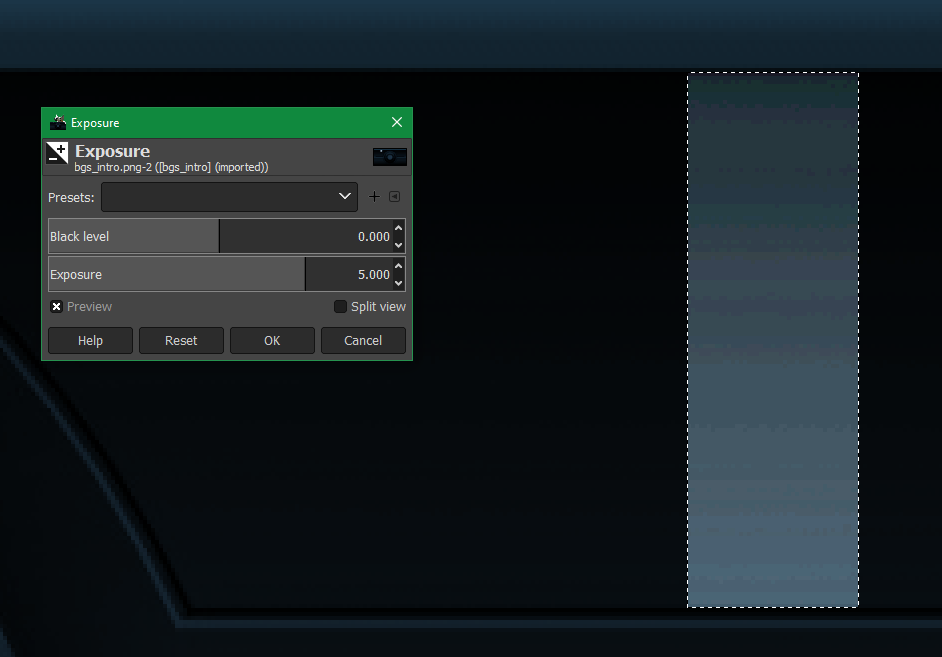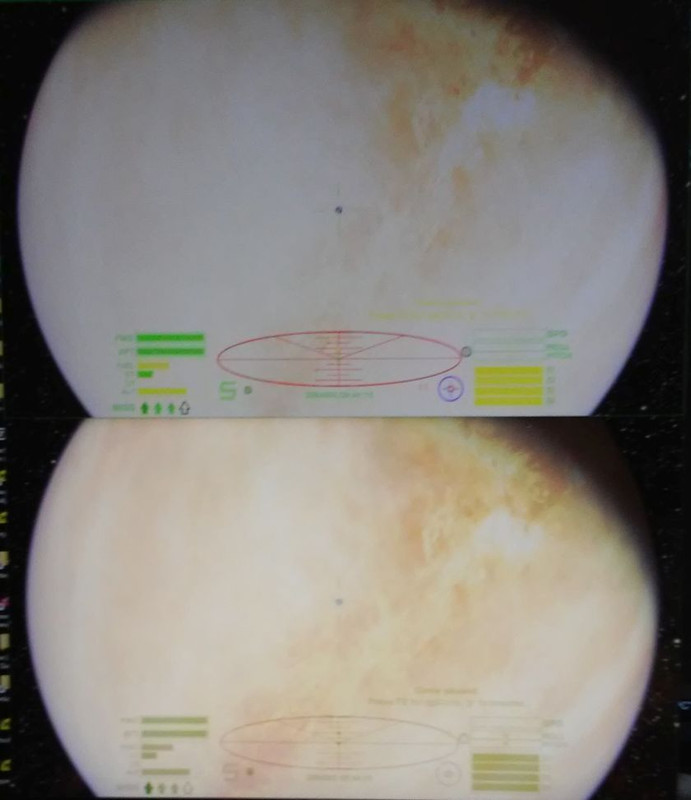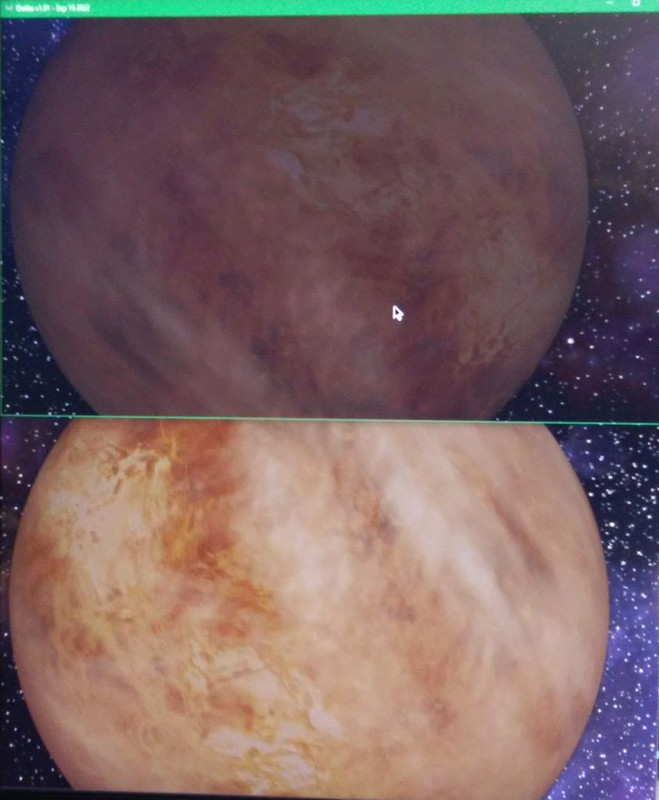Let me start with "very nice". Shiny bits are shinier, colors are vivid. My only complaint would be with the brightness. That could be down to the fragment values; I started with:
I disagree, in part due to my lack of communication skills. While they contain NO quantitative value, similar scenes on the screen at the same time may have some qualitative value. I took photos of my screen with 2 Oolite instances running, the top is normal, the bottom is using '-hdr'. They're mostly useless as they're out of focus (my fault) and don't do justice to the colors (camera's fault). At least you can get a feel for the difference.
The Cobra looks more polished, literally. When the light reflects off a small flat detail, the glint is more defined/less hazy. There is color banding in the background; you can even see it in my camera pic (bottom instance, upper right).
I examined the resource (bgs_intro.png) and it's there too, so not your fault; you've reproduced the banding faithfully! This will always be a problem when we increase color resolution with a gradient present. Station backgrounds will need an HDR version that has no gradients or be in an HDR compatible format(?).
I saw no banding once in space. The picture is much better, esp. seeing them side by side.
The planet in the 'normal' version seems washed out while the HDR one does not appear overly saturated.
Space is, well, full of stars! I know there are the same number but the dimmer ones are easier to see, so it looks busier. Not a bad thing, if you've ever seen the night sky from a rural location.
The nebulae really stand out. They're not over-done but when you look at the same one side by side, there are aspects you just cannot see in the 'normal' version. I ran with the -hdr parameter on a non-HDR display and they were more vivid & saturated. The HDR hits the sweet spot in-between.
The sun, however, has 2 problems. First, there is the central sphere surrounded by a cirular band just a hair dimmer than the sphere and as thick as the sun's diameter. In the 'normal' version, it's just a featureless sphere. Imagine you have a golf ball and a softball that have been rendered smooth (no dimples or stitches). The HDR version has you holding the golf ball in front of the softball while the 'normal' one has no golf ball. You cannot see it in my photo so I added the black ring to approximate its size.
Both suns have similar atmospheres but the HDR one has an inner 'border' (ie. there is a slim, faint ring between the sun and its atmosphere that is not present in the 'normal' version). When run with the -hdr parameter on a non-HDR display and position ship in planet's shadow, there is a similar 'border' effect (related?). Is it possible the sun/atmosphere has cirular banding?
The sun's other problem is glare. When I aimed at the sun's center, the 'normal' version had a bit of glare but the HDR has lots! About 30% on its way to being white!
Looking at my ship, I'm struck by the crispness of the sun's reflection off of the ship's details. The only real difference, which again could be down to my .fragment values, is the shadows are too light. I think that too much of the texture is visible when backlit by the sun. I'm between the planet and the sun, so is this down to planet-shine not apparent in 'normal' version? (ie. bug or feature
(see extra pics in dropbox folder below if your interested; I'm going to play w/ the .fragment values in the mean time)
I took my ship to the side of the planet opposite the sun, fully eclipsed and the planet's not dark enough.
With the external view, though, the ship's darkness was comparable in both versions but the HDR was still lighter.
Code: Select all
Opening log for Oolite version 1.91 (x86-64 test release) under Windows 10.0.19043.2006 64-bit at 2022-09-21 19:10:35 -0400.
AMD Ryzen 5 3600X 6-Core Processor 12 processors detected. System RAM: 32717 MB (free: 24962 MB).
Build options: OpenAL, GLSL shaders, new planets, JavaScript console support, OXP verifier, localization tools, debug GraphViz support, JavaScript profiling.
Note that the contents of the log file can be adjusted by editing logcontrol.plist.
19:10:36.035 [display.initGL]: V-Sync requested.
19:10:36.035 [display.mode.list.native]: Windows native resolution detected: 2560 x 1440
19:10:36.035 [display.initGL]: Trying 16-bpcc, 24-bit depth buffer
19:10:36.183 [gamma.set.failed]: ----- WARNING: Could not set gamma: Gamma ramp manipulation not supported
19:10:36.183 [display.initGL]: Achieved color / depth buffer sizes (bits):
19:10:36.183 [display.initGL]: Red: 16
19:10:36.183 [display.initGL]: Green: 16
19:10:36.183 [display.initGL]: Blue: 16
19:10:36.183 [display.initGL]: Alpha: 16
19:10:36.184 [display.initGL]: Depth Buffer: 24
19:10:36.184 [display.initGL]: Pixel type is float : 1
19:10:36.290 [joystick.init]: Number of joysticks detected: 1
19:10:36.292 [rendering.opengl.version]: OpenGL renderer version: 4.6.0 ("4.6.0 NVIDIA 512.15"). Vendor: "NVIDIA Corporation". Renderer: "NVIDIA GeForce RTX 2070 SUPER/PCIe/SSE2".
19:10:36.292 [rendering.opengl.extensions]: OpenGL extensions (400):
GL_NV_blend_square, GL_KHR_parallel_shader_compile, GL_ARB_map_buffer_range, GL_ARB_instanced_arrays, GL_ARB_shader_viewport_layer_array, GL_ARB_direct_state_access, GL_NV_memory_attachment, GL_ARB_clear_texture, GL_EXT_texture_compression_rgtc, GL_EXT_post_depth_coverage, GL_NV_texture_compression_vtc, GL_EXT_texture_storage, GL_NV_fragment_program, GL_ARB_query_buffer_object, GL_EXT_texture_shared_exponent, GL_EXT_sparse_texture2, GL_ARB_uniform_buffer_object, GL_EXT_texture_array, GL_ARB_shader_draw_parameters, GL_NV_mesh_shader, GL_ARB_shading_language_include, GL_ARB_separate_shader_objects, GL_NV_fragment_shader_interlock, GL_EXT_packed_pixels, GL_ARB_texture_query_levels, GL_ARB_fragment_layer_viewport, GL_NV_fence, GL_ARB_explicit_uniform_location, GL_ARB_stencil_texturing, GL_NV_conservative_raster, GL_EXT_gpu_program_parameters, GL_EXT_vertex_array, GL_EXT_provoking_vertex, GL_NV_draw_vulkan_image, GL_ARB_texture_view, GL_ARB_ES3_1_compatibility, GL_NV_texgen_reflection, GL_EXT_multi_draw_arrays, GL_NVX_gpu_multicast2, GL_ARB_clear_buffer_object, GL_EXT_texture_object, GL_EXT_packed_float, GL_EXT_texture_filter_anisotropic, GL_ARB_get_program_binary, GL_ARB_half_float_vertex, GL_ARB_program_interface_query, GL_EXT_bindable_uniform, GL_ARB_multi_draw_indirect, GL_NV_texture_multisample, GL_ARB_texture_buffer_object, GL_ARB_gpu_shader_fp64, GL_EXT_blend_minmax, GL_ARB_vertex_attrib_64bit, GL_ARB_texture_query_lod, GL_ARB_compressed_texture_pixel_storage, GL_EXT_texture_integer, GL_ARB_texture_non_power_of_two, GL_EXT_texture_compression_s3tc, GL_ARB_texture_stencil8, GL_KHR_no_error, GL_ARB_texture_mirror_clamp_to_edge, GL_ARB_framebuffer_no_attachments, GL_NV_parameter_buffer_object2, GL_ARB_shading_language_420pack, GL_ARB_sample_locations, GL_NV_texture_rectangle, GL_KHR_robustness, GL_SGIX_shadow, GL_EXT_vertex_array_bgra, GL_EXT_depth_bounds_test, GL_NV_conservative_raster_pre_snap, GL_NV_vertex_array_range2, GL_ARB_shader_texture_image_samples, GL_NV_vertex_program2, GL_ARB_texture_compression_bptc, GL_NV_vertex_program3, GL_EXT_stencil_wrap, GL_EXT_separate_shader_objects, GL_NV_shader_atomic_float, GL_NV_scissor_exclusive, GL_NV_packed_depth_stencil, GL_ARB_texture_gather, GL_ARB_shader_image_size, GL_EXT_texture_cube_map, GL_EXT_shader_image_load_formatted, GL_NV_register_combiners2, GL_NV_half_float, GL_ARB_map_buffer_alignment, GL_SUN_slice_accum, GL_ARB_provoking_vertex, GL_NV_shader_thread_shuffle, GL_ARB_tessellation_shader, GL_NV_stereo_view_rendering, GL_EXT_direct_state_access, GL_NVX_multigpu_info, GL_ARB_texture_rg, GL_NV_texture_shader2, GL_NV_texture_shader3, GL_ARB_bindless_texture, GL_SGIX_depth_texture, GL_NVX_linked_gpu_multicast, GL_NV_texture_env_combine4, GL_EXT_polygon_offset_clamp, GL_EXT_draw_range_elements, GL_EXT_draw_buffers2, GL_EXT_texture_filter_minmax, GL_ARB_transform_feedback2, GL_ARB_geometry_shader4, GL_ARB_fragment_coord_conventions, GL_ARB_transform_feedback3, GL_ARB_shader_precision, GL_NV_gpu_program_fp64, GL_NV_blend_equation_advanced_coherent, GL_NV_shader_atomic_counters, GL_ARB_get_texture_sub_image, GL_EXT_blend_color, GL_ARB_vertex_array_object, GL_NV_query_resource, GL_ATI_draw_buffers, GL_ARB_texture_mirrored_repeat, GL_EXT_stencil_two_side, GL_NV_shader_texture_footprint, GL_ARB_timer_query, WGL_EXT_swap_control, GL_NV_parameter_buffer_object, GL_EXT_texture_sRGB_decode, GL_NV_transform_feedback, GL_EXT_timer_query, GL_EXT_texture_edge_clamp, GL_EXT_shader_image_load_store, GL_NV_gpu_program4_1, GL_IBM_rasterpos_clip, GL_NV_framebuffer_multisample_coverage, GL_ARB_base_instance, GL_ARB_texture_float, GL_ARB_imaging, GL_ARB_draw_elements_base_vertex, GL_EXT_texture3D, GL_ARB_cull_distance, GL_EXT_packed_depth_stencil, GL_EXT_compiled_vertex_array, GL_ARB_texture_cube_map, GL_NV_uniform_buffer_unified_memory, GL_NV_primitive_restart, GL_EXT_blend_subtract, GL_EXT_separate_specular_color, GL_S3_s3tc, GL_NV_fragment_program_option, GL_EXTX_framebuffer_mixed_formats, GL_ARB_texture_compression, GL_ARB_gl_spirv, GL_ARB_texture_compression_rgtc, GL_ARB_texture_filter_anisotropic, GL_ARB_ES2_compatibility, GL_NV_shader_subgroup_partitioned, GL_ARB_shader_ballot, GL_NV_gpu_multicast, GL_NV_shader_atomic_float64, GL_NVX_blend_equation_advanced_multi_draw_buffers, GL_ARB_depth_buffer_float, GL_NV_light_max_exponent, GL_ARB_vertex_buffer_object, GL_KHR_blend_equation_advanced, GL_NV_shader_atomic_int64, GL_ARB_shading_language_100, GL_NV_shader_storage_buffer_object, GL_ARB_texture_env_add, GL_ARB_fragment_program, GL_NV_copy_depth_to_color, GL_ARB_sparse_buffer, GL_EXT_import_sync_object, GL_EXT_texture_swizzle, GL_ARB_shadow, GL_NV_conservative_raster_pre_snap_triangles, GL_ARB_texture_filter_minmax, GL_NV_shading_rate_image, GL_NV_copy_image, GL_NVX_progress_fence, GL_NV_clip_space_w_scaling, GL_ARB_shader_texture_lod, GL_ARB_clip_control, GL_NV_conservative_raster_dilate, GL_ARB_texture_multisample, GL_EXT_texture_env_combine, GL_ARB_sync, GL_ATI_texture_mirror_once, GL_ARB_robustness, GL_ARB_compatibility, GL_EXT_texture_compression_dxt1, GL_NV_gpu_program4, GL_NV_gpu_program5, GL_ARB_transform_feedback_overflow_query, GL_NV_vertex_array_range, GL_ARB_multitexture, GL_EXT_transform_feedback2, GL_NV_vertex_program2_option, GL_KHR_shader_subgroup, GL_ARB_buffer_storage, GL_NV_compute_program5, GL_NV_vertex_program1_1, GL_NV_gpu_program5_mem_extended, GL_NV_conservative_raster_underestimation, GL_EXT_shadow_funcs, GL_ARB_occlusion_query, GL_ARB_fragment_program_shadow, GL_NVX_nvenc_interop, GL_NV_vertex_buffer_unified_memory, GL_ARB_texture_barrier, GL_EXT_geometry_shader4, GL_EXT_memory_object_win32, GL_ARB_texture_env_dot3, GL_ARB_seamless_cubemap_per_texture, GL_ARB_multisample, GL_ARB_copy_image, GL_ARB_gpu_shader_int64, GL_ARB_color_buffer_float, GL_EXT_texture_env_add, GL_ARB_ES3_compatibility, GL_ARB_point_parameters, GL_ARB_sampler_objects, GL_ARB_transform_feedback_instanced, GL_ARB_invalidate_subdata, GL_KTX_buffer_region, GL_NV_vertex_attrib_integer_64bit, GL_NV_bindless_multi_draw_indirect, GL_NV_sample_mask_override_coverage, GL_NVX_gpu_memory_info, GL_EXT_framebuffer_object, GL_NV_gpu_shader5, GL_ARB_texture_rgb10_a2ui, GL_NV_shader_atomic_fp16_vector, GL_NV_ES1_1_compatibility, GL_ARB_texture_border_clamp, GL_NV_alpha_to_coverage_dither_control, GL_ARB_shading_language_packing, GL_NV_fragment_shader_barycentric, GL_EXT_bgra, GL_ATI_texture_float, GL_ARB_occlusion_query2, GL_ARB_shader_clock, GL_ARB_texture_env_crossbar, GL_NV_shader_buffer_load, GL_NV_feature_query, GL_NV_depth_clamp, GL_ARB_derivative_control, GL_ARB_conservative_depth, GL_AMD_vertex_shader_layer, GL_EXT_win32_keyed_mutex, GL_AMD_multi_draw_indirect, GL_ARB_shader_atomic_counters, GL_ARB_texture_env_combine, GL_EXT_framebuffer_multisample, GL_NV_occlusion_query, GL_EXT_Cg_shader, GL_NV_texture_barrier, GL_NV_path_rendering, GL_ARB_ES3_2_compatibility, GL_ARB_draw_buffers, GL_SGIS_generate_mipmap, GL_NV_path_rendering_shared_edge, GL_ARB_texture_buffer_object_rgb32, GL_EXT_window_rectangles, GL_NVX_conditional_render, GL_NV_register_combiners, GL_EXT_texture_sRGB_R8, GL_EXT_framebuffer_blit, GL_ARB_vertex_array_bgra, GL_NV_multisample_coverage, GL_EXT_texture_shadow_lod, GL_EXT_fog_coord, GL_ARB_window_pos, GL_NV_fill_rectangle, GL_ARB_half_float_pixel, GL_SGIS_texture_lod, GL_IBM_texture_mirrored_repeat, GL_EXT_texture_lod, GL_EXT_blend_equation_separate, GL_OVR_multiview2, GL_ARB_point_sprite, GL_ARB_parallel_shader_compile, GL_NV_fragment_program2, GL_ARB_shader_group_vote, GL_ARB_fragment_shader, GL_NV_blend_minmax_factor, GL_ARB_framebuffer_sRGB, GL_EXT_memory_object, GL_ARB_shader_objects, GL_NV_internalformat_sample_query, GL_WIN_swap_hint, GL_ARB_polygon_offset_clamp, GL_EXT_framebuffer_multisample_blit_scaled, GL_ARB_sparse_texture_clamp, GL_ARB_blend_func_extended, GL_ARB_shader_subroutine, GL_NV_pixel_data_range, GL_NV_viewport_swizzle, GL_NV_memory_object_sparse, GL_ARB_sparse_texture, GL_ARB_multi_bind, GL_KHR_debug, GL_EXT_multiview_timer_query, GL_NV_representative_fragment_test, GL_NV_framebuffer_mixed_samples, GL_ARB_transpose_matrix, GL_EXT_texture_compression_latc, GL_ARB_texture_cube_map_array, GL_NV_ES3_1_compatibility, GL_ARB_texture_buffer_range, GL_ARB_robust_buffer_access_behavior, GL_ARB_texture_storage_multisample, GL_EXT_texture_env_dot3, GL_NV_compute_shader_derivatives, GL_ARB_vertex_type_10f_11f_11f_rev, GL_EXT_texture_sRGB, GL_EXT_secondary_color, GL_EXT_point_parameters, GL_ARB_shader_image_load_store, GL_EXT_pixel_buffer_object, GL_ARB_explicit_attrib_location, GL_ARB_internalformat_query2, GL_ARB_seamless_cube_map, GL_ARB_draw_instanced, GL_ARB_draw_buffers_blend, GL_NV_sample_locations, GL_ARB_post_depth_coverage, GL_NV_fragment_coverage_to_color, GL_EXT_draw_instanced, GL_ARB_pipeline_statistics_query, GL_NV_texture_rectangle_compressed, GL_ARB_framebuffer_object, GL_ARB_internalformat_query, GL_OVR_multiview, GL_EXT_texture_mirror_clamp, GL_ARB_texture_rectangle, GL_ARB_gpu_shader5, GL_EXT_gpu_shader4, GL_ARB_compute_shader, GL_AMD_seamless_cubemap_per_texture, GL_NV_fog_distance, GL_EXT_multiview_texture_multisample, GL_ARB_spirv_extensions, GL_ARB_depth_clamp, GL_KHR_robust_buffer_access_behavior, GL_NV_texture_shader, GL_NV_shader_thread_group, GL_NV_float_buffer, GL_ARB_vertex_type_2_10_10_10_rev, GL_KHR_blend_equation_advanced_coherent, GL_AMD_vertex_shader_viewport_index, GL_ARB_shader_storage_buffer_object, GL_NV_conditional_render, GL_ARB_vertex_program, GL_ARB_enhanced_layouts, GL_ARB_compute_variable_group_size, GL_NV_bindless_texture, GL_ARB_draw_indirect, GL_ARB_arrays_of_arrays, GL_NV_multisample_filter_hint, GL_ARB_indirect_parameters, GL_ARB_viewport_array, GL_NV_point_sprite, GL_ARB_texture_storage, GL_NV_geometry_shader4, GL_EXT_semaphore, GL_ARB_texture_swizzle, GL_ARB_sparse_texture2, GL_EXT_texture_lod_bias, GL_EXT_semaphore_win32, GL_EXT_abgr, GL_NV_viewport_array2, GL_ARB_vertex_shader, GL_ARB_vertex_attrib_binding, GL_NV_transform_feedback2, GL_ARB_depth_texture, GL_NV_query_resource_tag, GL_NV_vertex_program, GL_NV_blend_equation_advanced, GL_EXT_framebuffer_sRGB, GL_ARB_shader_atomic_counter_ops, GL_ARB_copy_buffer, GL_NV_depth_buffer_float, GL_EXT_raster_multisample, GL_ARB_pixel_buffer_object, GL_NV_explicit_multisample, GL_EXT_texture_buffer_object, GL_EXT_blend_func_separate, GL_ARB_fragment_shader_interlock, GL_NV_command_list, GL_NV_geometry_shader_passthrough, GL_NV_draw_texture, GL_EXT_vertex_attrib_64bit, GL_NV_timeline_semaphore, GL_EXT_rescale_normal, GL_ARB_sample_shading, GL_ARB_shader_bit_encoding, GL_KHR_context_flush_control, GL_EXT_shader_integer_mix, GL_NV_bindless_multi_draw_indirect_count, GL_ARB_debug_output, GL_ARB_conditional_render_inverted
19:10:36.308 [rendering.opengl.shader.support]: Shaders are supported.
19:10:36.379 [MSAA.setup]: Multisample anti-aliasing not requested.
19:10:40.060 [display.initGL]: Requested a new surface of 1194 x 716, windowed.
19:10:40.120 [display.initGL]: Created a new surface of 1194 x 716, windowed.
19:10:40.128 [startup.complete]: ========== Loading complete in 4.21 seconds. ==========
P.S. For future testing, could you make me a differential archive (only new files)? My internet access is crap (almost an hour to DL)







